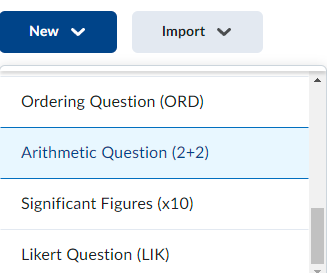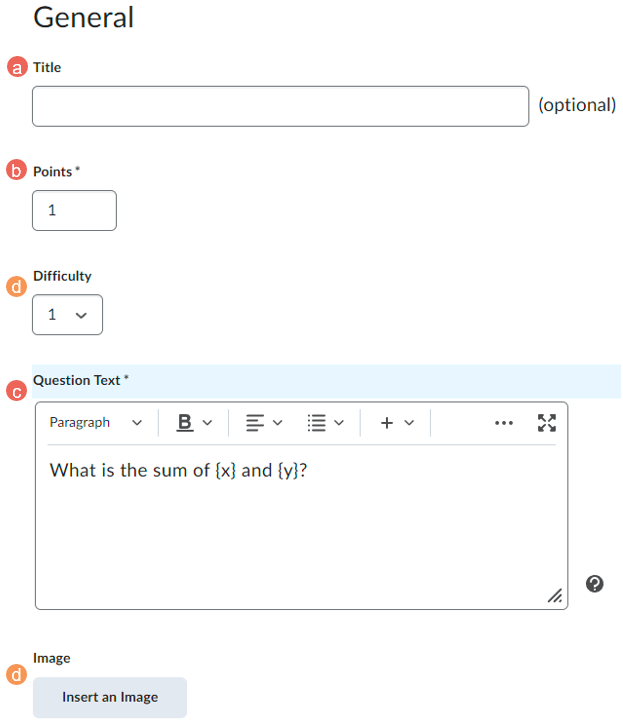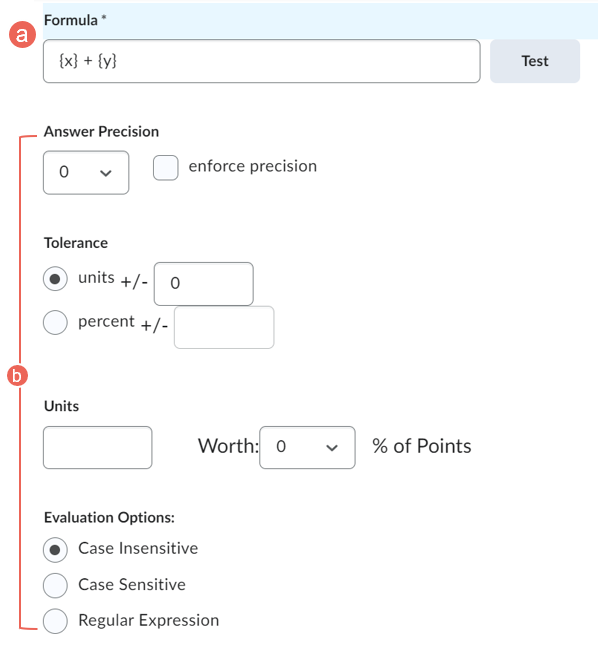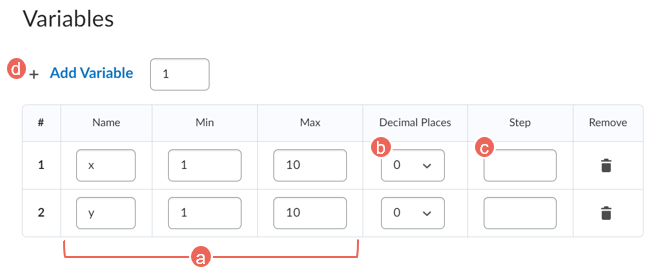Creating Arithmetic Questions (2+2)
Arithmetic questions (2+2) enable you to assess students' knowledge and comprehension of mathematics and number theory. Ensure each respondent receives a unique question by including set variables that randomly generate numbers within the problem.
For example, if variables x and y have a min value of 0 and max value of 6 with a step value of 2. Variables for each student will be randomly selected from (0, 2, 4, 6). For the equation {x} + {y}, one student may see 2 + 6, and the next student may see 6 + 6.
Here are the steps to create an arithmetic question:
- Access a Question Library or Quiz
- Create an Arithmetic Question
- Enter Question Details and Save
- Enter the question text
- Define the arithmetic formula
- Define the variables
- Provide hints and feedback (optional)
Related guides
- Create arithmetic questions, by D2L
- Quiz question converter - create a file to import questions
- Creating Questions in the Question Library
- Creating a Quiz (new interface)
Step One: Access a Question Library or Quiz
Questions can be created in a Question Library or Quiz. For a Quiz, it is recommended to first create questions in the Question Library, then import them into the Quiz. For additional information see the following guides, then return to take the next step:
- Option 1: Creating Questions in the Question Library
- Option 2: Creating a Quiz (new interface)
Step Two: Create an Arithmetic Question
1. From New select Arithmetic Question (2+2).

Step Three: Enter Question Details and Save
Enter the question text
1. Fill in general details such as:
- (a) Title: is used for searching or later importing into a quiz.
- Assign (b) Points for the fill in the blanks task.
- Enter (c) Question Text. Ensure each variable must be contained within curly braces { }.
- (d) Optional: Choose a Difficulty level from the dropdown list or choose to Insert an Image to upload an image to accompany your question.

Define the arithmetic formula
2. Next,
- Enter your arithmetic question formula. Ensure each variable must be contained within curly braces { }.
- For example: What is the sum of {x} and {y}? Your formula would be {x} + {y}, which will take a random value for the x variable + with a random value for the y variable.
- See create arithmetic questions, by D2L for a list of supported operations, functions, and constants.
- Optional - Refine answer criteria: You can use Answer Precision to control how many decimals points students should enter, Tolerance to accept a given range of answers from students, and then select Evaluation Option.

Define the variables
3. Define mathematical Variables such as:
- Give each variable a Name (e.g: x), a minimum value in Min, and a maximum value in Max. The system will later generate a random number within this range.
- Enter Decimal Places to select the applicable number of decimal places for the variable to have.
- Step: sets increments for the min and max values when choosing your variables.
- For example, a step value of 2 would only choose variables that are increments of 2 such as 2,4,6,8,10.
- To add more variables, select +Add Variable.

Provide hints and feedback (optional)
4 (Optional). You can provide students with hints to help them answer the question, and enter feedback to show students after they have completed the question. To do so, select Expand question hint or Expand question feedback.

5. When complete select one of the save options
- Save – save the question and return to the question library, quiz or survey
- Preview - view how the question will be displayed to students
- Save and New – save the question, then create a new question
- Save and Copy – save the question, then create a copy of the current questions



